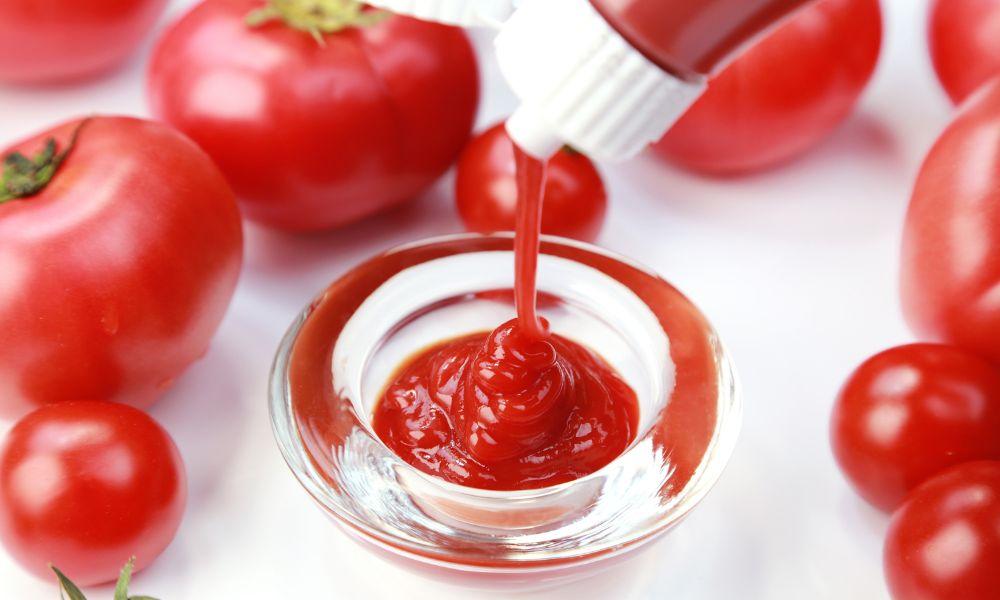If you’ve ever wondered about the origins of that familiar red sauce that’s slathered on your favorite burger or fries, you’re not alone. With a history that’s as flavorful as the condiment itself, ketchup, or should we say ‘catsup,’ often ignites a heated debate.
From the days of its origin to its widespread use in contemporary cuisine, ketchup has embarked on quite a remarkable journey. So, let’s dive into understanding the evolution of this iconic condiment. And a quick reminder: It’s not just a tale about a sauce—it’s a tale dipped in cultural exchange, culinary innovation, and linguistic transformation too!

Origin and Historical Journey
The term ‘ketchup’ is believed to have originated from the Chinese fish sauce Ke-Chiap. But wait—there’s a twist. The early ketchup had nothing to do with tomatoes! Yes, that’s right. The original recipe was a far cry from the sweet, tangy delight we’re familiar with today.
Back in the day, European traders were significantly intrigued by Asian condiments—and Ke-Chiap was no exception. They brought this unique sauce back home in the 17th century, giving it a warm European embrace. Ketchup’s name may also have found its roots in Indonesian sauces such as kicap and kecap contributing to the name, thereby paving the way for a rich, multi-cultural culinary inheritance.
Early Forms of Ketchup
Early variations of ketchup bore no resemblance to our beloved condiment. It was made from various ingredients such as mushrooms, walnuts, oysters, and even fruits. Murky, briny, and tangy—the early versions of ketchup were worlds apart from today’s perfectly balanced blend of sweet and sour.
A melody of words, including ‘catchup’ and ‘catsup,’ was used to refer to these sauces. The Irish author and cleric Jonathan Swift mentioned ‘Catsup’ in a poem in 1730, thereby adding to the growing popularity of the alternative spelling. If you stumbled upon the query ‘origin of catsup’—well, now you know!
Incorporation of Tomatoes

The journey of ketchup took an adventurous turn when tomatoes were introduced into the recipe. Prior to this, tomatoes were considered poisonous—not exactly the kind of ingredient you’d want in your food, right?
However, things took a turn, and in the 19th century, recipes began incorporating these vibrant red fruits, giving birth to a sauce that was remarkably similar to the ketchup we know and love. Tomato-based ketchup soon became a staple in American households, capturing the hearts of culinary enthusiasts with its rich flavor profile and versatility.
Why was this version more popular, you ask? Catsup vs ketchup flavor differences played a big part. The tomato version brought with it a sweet tanginess that wasn’t prevalent in the older versions. Plus, the vibrant scarlet hue made it aesthetically pleasing.
The Rise of Commercial Ketchup

The transition from homemade condiment to commercially produced ketchup started with local farmers. They prepared and bottled their ketchup for their community, sowing the seeds of what would soon become a booming industry.
Then, in 1876, the H. J. Heinz Company threw its hat in the ring and started producing ketchup. Fun fact for all the Ketchup history buffs out there: Heinz opted for the spelling ‘ketchup’ to differentiate itself from competing products labeled ‘catsup.’ It seems like the catsup vs ketchup saga had started creating ripples in the business world too!
Ingredients and Variations

The core ingredients of ketchup are quite simple—tomatoes, vinegar, sugar, and a blend of spices. These, when cooked down, create the smooth, rich condiment we know today. However, the variations in the recipes are only limited by imagination, with options to add vegetables like onions and celery for extra flavor.
These differences in ingredients often lead to catsup vs ketchup: taste differences. While traditional ketchup tends to have a sweet and tangy flavor, catsup is often slightly less sweet and a bit spicier, depending on the region.
To give you an anecdote from my personal experiences – back in the day when I, John Bird, was working at the Boat Basin Café in downtown New York (before it closed down), we used to have endless debates about catsup vs ketchup: Best for burgers! Some of us swore by the slightly spicier note of catsup, while others couldn’t dream of parting from the sweet tanginess of ketchup.
The debate is timeless, but it all boils down to personal preference. Some might even say that the ‘catsup vs ketchup: regional preferences’ play a part. So, no matter where you are or what you prefer, remember to enjoy your ketchup or catsup as you like it!
The journey of ketchup is indeed fascinating, rich with historical context and nuances. But that’s not all. Stay tuned as we take a deeper look into the prevalence of “ketchup” over “catsup” today, its continued popularity, and the role it plays in culinary culture worldwide in the second part of this article.
And remember, whether you’re weighing up ‘catsup vs ketchup: health benefits’ or exploring the role these sauces play in your culinary adventures, the world of ketchup and catsup is filled with more than just flavor—it’s a tale of food, culture, and linguistic evolution!
Ketchup Today
Despite the historical skirmishes in the naming, the term ‘ketchup’ has steadily overshadowed ‘catsup’ in contemporary times. As per the linguistic experts, the reason ketchup is more prevalent than catsup could be attributed to the influence of high-profile brands like Heinz using the term ‘ketchup’. This has led to ‘ketchup’ being universally recognized and used more commonly than ‘catsup’ across the globe.
When it comes to its culinary applications, ketchup retains its superstar status. From being a dipping sauce for fries to a key ingredient in numerous Eastern and Western dishes, you’ll find ketchup almost everywhere. In fact, the ketchup of today is considered a staple in most American households.
Let’s not forget that ‘catsup vs ketchup: regional preferences’ still exist. Certain regions in the Southern United States and some parts of Latin America still use ‘catsup.’ It’s fascinating to see how geographical locations and cultural nuances play a role in which term is preferred!
Catsup vs Ketchup: The Great Debate
| Ketchup | Catsup | |
|---|---|---|
| Origin | Derived from Chinese fish sauce Ke-Chiap, introduced to Europe in the 17th century | Mentioned in a poem by Jonathan Swift in 1730 |
| Early Forms | Made from mushrooms, walnuts, oysters and fruits | Similar to ketchup with varied ingredients |
| Tomato Incorporation | Incorporated in the 19th century, making ketchup sweeter and tangier | Similar to ketchup, may be less sweet and slightly spicier |
| Commercial Production | H. J. Heinz Company started production in 1876, chose ‘ketchup’ for differentiation | Labeled as ‘catsup’ by some rival companies |
| Ingredients | Made from tomatoes, vinegar, sugar, and a blend of spices. Variations may include onions or celery | Likely very similar to ketchup |
| Usage Today | Globally more common due to high-profile brands like Heinz | Preferred in some regions of Southern US and Latin America |
| Flavor | Sweet and tangy | Slightly less sweet and a bit spicier |
| Health Benefits | Low in calories and fat, high in sodium and sugar | Similar to ketchup, with minor differences in nutritional content |
| Culinary Applications | Used as a dipping sauce and ingredient in numerous dishes across cultures | Similar to ketchup, usage might vary based on region and personal preference |
Amid the ketchup and catsup conundrum, you might wonder if there are any significant differences between the two, aside from their names. In terms of flavor, catsup is often described as tangier and spicier compared to ketchup. However, the flavor differences are usually subtle.
The debate goes beyond mere flavor though. From the health benefits to the best-suited culinary applications—there are many different factors to consider. For instance, catsup vs ketchup: health benefits is a topic frequently brought up by health-conscious consumers. While there are minor differences in nutritional content, both sauces are relatively low in calories and fat but high in sodium and sugar.
Perhaps you’re more interested in which is best on your burger. The choice between ‘catsup vs ketchup: best for burgers’ is, again, a subjective one and completely comes down to personal preference and regional influences.
Conclusion:
The journey of ketchup is a testament to the evolution of food culture and the power of language. From its origin as a fish sauce to its present-day status as a beloved worldwide condiment, ketchup—or catsup, depending on who you ask—has a rich and vibrant history that adds to its charm.
Whether you’re exploring the ‘catsup vs ketchup: history and evolution’, comparing ‘catsup vs ketchup: taste and usage’, or simply curious about the ‘catsup vs ketchup: naming debate’, it’s clear that this condiment is a lot more than just a tangy addition to your fries.
While ketchup and catsup might differ in name and slight nuances in taste, one thing unites them—their ability to elevate the flavor profile of a wide array of dishes. So, the next time you squeeze that bottle of ketchup or catsup onto your plate, take a moment to appreciate the dish’s storied journey that transcends continents, cultures, and centuries!






